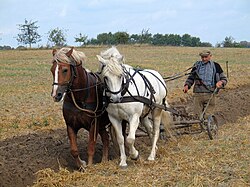Recently: a wider and more balanced approach
A second, more nuanced definition of low-tech may appear. This definition takes into account the philosophical, environmental and social aspects. Low-tech are no longer restricted to old techniques, but also extended to new, future-oriented techniques, more ecological and intended to recreate social bounds. A low-tech innovation is then possible. [10]
Contrary to the first definition, this one is much more optimistic and has a positive connotation. It would then oppose the planned obsolescence of objects (often "high-tech") and question the consumer society, as well as the materialist principles underneath. With this definition, the concept of low-tech thus implies that anyone could make objects using their intelligence, and share their know-how to popularize their creations. A low-tech must therefore be accessible to all, and could therefore help in reduction of inequalities. [10]
Furthermore, some reduce the definition of low-tech to meet basic needs (eating, drinking, housing, heating ...), which disqualifies many technologies from the definition of low-techs, but this definition does not is not always accepted. [12] Finally, considering that the definition of low-tech is relative, some prefer to use lower tech. [10]






